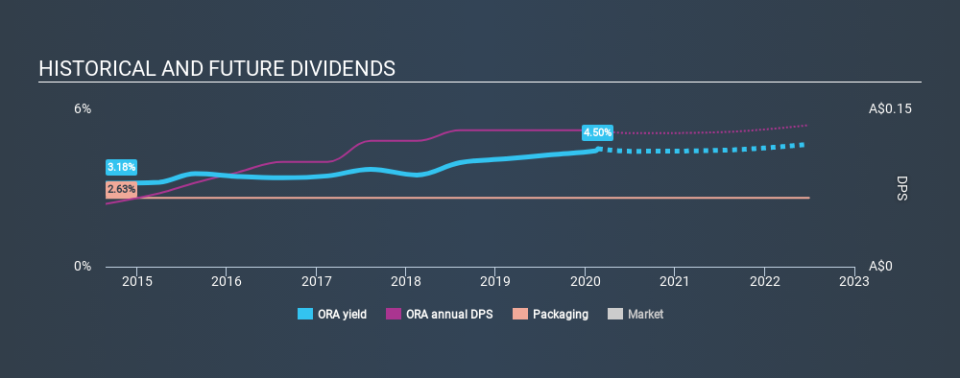Why It Might Not Make Sense To Buy Orora Limited (ASX:ORA) For Its Upcoming Dividend

Orora Limited (ASX:ORA) is about to trade ex-dividend in the next 4 days. Investors can purchase shares before the 26th of February in order to be eligible for this dividend, which will be paid on the 9th of April.
Orora's next dividend payment will be AU$0.065 per share, on the back of last year when the company paid a total of AU$0.13 to shareholders. Based on the last year's worth of payments, Orora stock has a trailing yield of around 4.5% on the current share price of A$2.89. Dividends are an important source of income to many shareholders, but the health of the business is crucial to maintaining those dividends. So we need to investigate whether Orora can afford its dividend, and if the dividend could grow.
View our latest analysis for Orora
Dividends are typically paid out of company income, so if a company pays out more than it earned, its dividend is usually at a higher risk of being cut. Last year Orora paid out 104% of its profits as dividends to shareholders, suggesting the dividend is not well covered by earnings. That said, even highly profitable companies sometimes might not generate enough cash to pay the dividend, which is why we should always check if the dividend is covered by cash flow. Orora paid out more free cash flow than it generated - 181%, to be precise - last year, which we think is concerningly high. It's hard to consistently pay out more cash than you generate without either borrowing or using company cash, so we'd wonder how the company justifies this payout level.
As Orora's dividend was not well covered by either earnings or cash flow, we would be concerned that this dividend could be at risk over the long term.
Click here to see the company's payout ratio, plus analyst estimates of its future dividends.
Have Earnings And Dividends Been Growing?
Stocks in companies that generate sustainable earnings growth often make the best dividend prospects, as it is easier to lift the dividend when earnings are rising. If business enters a downturn and the dividend is cut, the company could see its value fall precipitously. This is why it's a relief to see Orora earnings per share are up 6.5% per annum over the last five years. Earnings per share have been growing steadily, although a payout ratio this high suggests future growth is likely to slow, and the dividend may also be at risk of a cut if business enters a downturn.
The main way most investors will assess a company's dividend prospects is by checking the historical rate of dividend growth. Orora has delivered an average of 17% per year annual increase in its dividend, based on the past five years of dividend payments. We're glad to see dividends rising alongside earnings over a number of years, which may be a sign the company intends to share the growth with shareholders.
The Bottom Line
From a dividend perspective, should investors buy or avoid Orora? The dividends are not well covered by either income or free cash flow, although at least earnings per share are slowly increasing. It's not the most attractive proposition from a dividend perspective, and we'd probably give this one a miss for now.
Wondering what the future holds for Orora? See what the six analysts we track are forecasting, with this visualisation of its historical and future estimated earnings and cash flow
If you're in the market for dividend stocks, we recommend checking our list of top dividend stocks with a greater than 2% yield and an upcoming dividend.
If you spot an error that warrants correction, please contact the editor at editorial-team@simplywallst.com. This article by Simply Wall St is general in nature. It does not constitute a recommendation to buy or sell any stock, and does not take account of your objectives, or your financial situation. Simply Wall St has no position in the stocks mentioned.
We aim to bring you long-term focused research analysis driven by fundamental data. Note that our analysis may not factor in the latest price-sensitive company announcements or qualitative material. Thank you for reading.



